Common Tennis Injuries
Tennis Elbow
What is Tennis Elbow?
Tennis elbow (lateral epicondylitis) is an overuse injury affecting tendons of your forearm muscles that attach to the outside of your elbow (lateral epicondyle). This condition is also not just limited to tennis or racket sports but anyone who stresses the wrist extensors and supinator muscles of their forearm.
Symptoms: in most cases, mild pain or a burning sensation starts on the outer part of the elbow. It may also lead to a weak grip and even pain at night. Symptoms worsen with forearm activity such as holding a racket, turning a wrench or wringing out a wet towel.
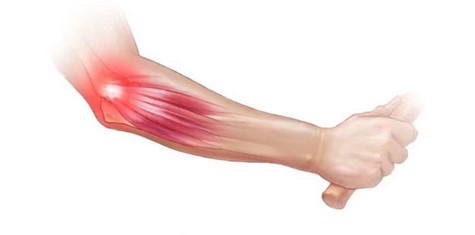
Causes: Tennis elbow pain is generally an overuse injury. There are small tears over the extensor carpi radialis brevis (ECRB) muscle which helps to stabilise the wrist when the elbow is straight. Microscopic tears form in the tendon of the ECRB as it attached to the lateral epicondyle
What can happen if Tennis Elbow is left untreated?
Neglected tennis elbow may lead to mild pain, which can degenerate into a severe and debilitating injury. This may be accompanied by weakness during grip activities or a loss of function. Painters, cooks, and plumbers are prone to this injury due to the nature of their jobs and the repetitive weightlifting and forearm twisting activities that they perform daily.
Diagnosis of Tennis Elbow
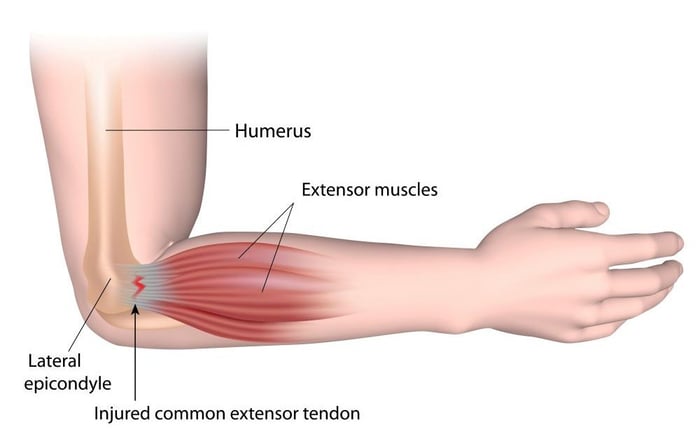
Your doctor may recommend some imaging to diagnose the injury and exclude other injuries around the elbow.
An X-ray will give your doctor information about the bone structure of the elbow as well as to exclude arthritis.
An MRI scan will provide detailed images of the bones and soft tissue around the elbow, including possible tears of the ECRB which may be causing the symptoms on the outside of the elbow.
Other differential diagnoses such a cubital tunnel syndrome of the elbow may require other imaging modalities such as an electromyography (EMG). This may be done after your doctor clinically assess your elbow and symptoms.
Treatment Options
o It is important to diagnose this injury once you get pain on the outside of your elbow.
o Rest from the activity helps to protect the elbow from further damage.
o Reducing swelling and inflammation of the area by applying ice for 20 to 30 minutes every 3 to 4 hours for 2 to 3 days or until the pain is gone.
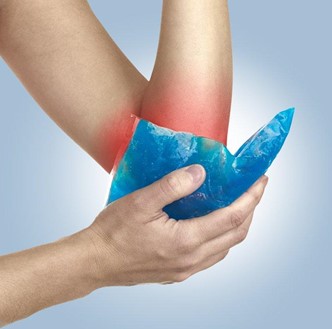
o Anti-inflammatory medication is helpful to reduce pain and swelling to accelerate your recovery.
o Wear a brace. Consider wearing a forearm muscle splint for either golfers’ or tennis elbow. This brace is worn about two finger-breadths below the elbow crease and works to take the strain off the affected tendon. This brace is to be worn even when not playing tennis, and advisably for a period of about 4 to 6 weeks.
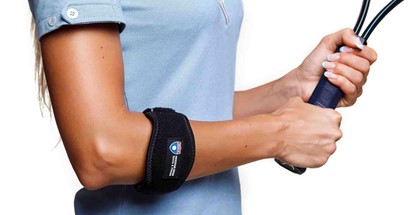
o Physical therapy or physiotherapy will help to strengthen the muscles of the forearm and stretch out tight muscles. Treatment modalities such as ultrasound, massage, ice and muscle simulating techniques may accelerate your healing.
o Injections around the painful area may help with pain and reduce swelling. This may be in the form of a combined injection containing a local anaesthetic or steroid.
o Extracorporeal shock wave therapy uses sound waves to promote healing of microscopic tears of the ECRB tendon.
o Open or arthroscopic surgical repair of the torn ECRB tendon may be indicated in recalcitrant cases. These surgeries are rarely needed with adequate rest and non-surgical treatment.
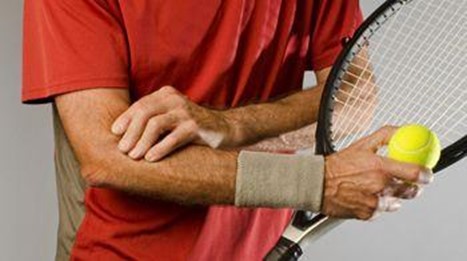
Recovery
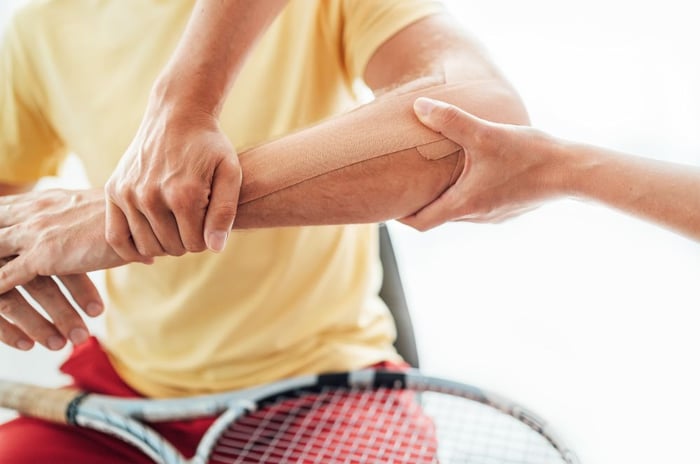
This depends on many factors such as the severity of the injury and the type of aggravating physical activities that one does. It often takes about 4 to 6 weeks for tennis elbows to recover.
What to do now while waiting for diagnosis/treatment?
○ Refrain from strenuous forearm physical activities for a week or two once you start developing symptoms. Application of ice and consumption of anti-inflammatory medication will help with pain and burning sensation associated with tennis elbow.
○ Do not rush your recovery. This may have an unwanted effect of aggravating your injury and delaying your return to sports.
There are several things you can do to reduce the stress on your forearm muscles and prevent getting a Tennis Elbow:
1. Grip strength.
If you clutch or grip your racket too hard, you will undoubtedly stress the muscles of your forearm and may develop pain on the inside or outside of your elbow, or both. Relax your grip and reduce the tempo of your swing.
2. Grip size.
Consider the size of the grips of your racket. If the grip is too small, you will end up unnecessarily stressing the muscles in your forearm. Reduce the stress on your forearm muscle by using a larger grip for your racket.
3. Grip quality.
Some golfers are guilty of never changing the grip for our clubs. Each grip has a specific firmness and texture that would suit your individual game. Grips that are worn out with little texture will make players use excessive hand pressure to create a confident grip on their club. This lack of hand traction and gripping confidence will overstrain your forearm muscles, thus leading to pain around the elbow.
Tennis Elbow Treatment Process
How Would My Elbow Be Examined, Diagnosed and Treated?
Same-Day Appointments Available
Prompt Examination And Diagnosis
Minimally Invasive Non-Surgical Options
Surgery Only When Necessary
You don’t have to play tennis to develop a tennis elbow. The typical pain on the outside of the elbow is related to repetitive and strenuous wrist movements. Non-surgical modalities like physiotherapy, analgesia, injections and changes in physical activities may help your elbow injury recovery. Surgery is often the last resort.
Dr Mizan will examine your elbow and assess its aggravating factors before discussing with you a customised treatment plan.
1. Examination
Your orthopaedic surgeon will obtain a thorough medical history and determine how you sustained the injury. A clinical examination of your arm will be performed to look for tenderness, stability and flexibility.
2. Diagnosis
An X-ray will give your doctor information about the bone structure of the elbow and exclude conditions such as arthritis and fractures. An MRI scan will provide detailed images of the ligaments and tendons around the elbow, including possible tears of the extensor carpi radialis brevis (ECRB) tendon which may be causing your symptoms.
3. Treatment
It is important to diagnose this injury once you experience pain on the outside of your elbow. Refraining from aggravating activities helps to protect the elbow from further damage.
Reduce elbow swelling and inflammation by applying ice for 30 minutes every 3 to 4 hours for a few days or until the pain is gone.
Anti-inflammatory medication can also help to reduce the pain and swelling, thus accelerating your recovery.
Consider wearing a forearm muscle splint, or brace, for either golfers’ or tennis elbow. This brace is worn about two finger-breadths below the elbow crease and works by taking the strain off the affected tendon. It is recommended to wear the brace even when you are not playing tennis, and for a period of about 4 to 6 weeks.
Physical therapy or physiotherapy will help to strengthen the muscles of the forearm and stretch out tight muscles. Treatment modalities such as ultrasound, massage, ice and muscle simulating techniques may accelerate your healing.
Injections around the painful area may help to alleviate the pain and reduce swelling. This may be in the form of a combined injection containing a local anaesthetic or steroid.
Extracorporeal shockwave therapy uses sound waves to promote healing of microscopic tears of the ECRB tendon.
Open or arthroscopic surgical repair of the torn ECRB tendon may be indicated in recalcitrant cases. These surgeries are rarely needed with adequate rest and non-surgical treatment.
Can tennis elbow (lateral epicondylitis) go away on its own?
Yes it can. However it is important to identify what caused it in the first place. Often it is repetitive and strenuous activities that involve the wrist such as cooking, using a screwdriver or gripping something tightly that causes it. Your symptoms will improve if you avoid these aggravating activities. Methods to reduce inflammation such as medication, ice and injections are also helpful to improve the symptoms of tennis elbow. Symptoms may last for several months depending on its severity and your level of physical activity.
Knee Pain after Tennis
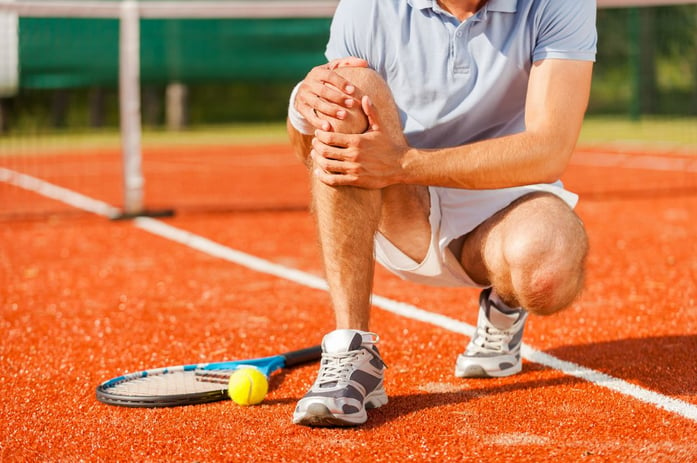
Do you get knee pain after tennis?
This is more likely if you play tennis regularly. There is a tremendous amount of stress to the knee during tennis, especially if you are running to the net to save that drop shot or sliding sideways to return a ball. That anterior knee pain you are experiencing could be due to patella-femoral pain or inflammation around the patella tendon.
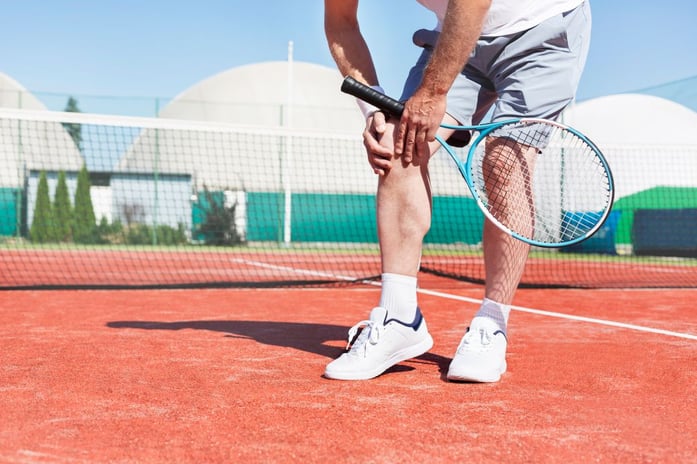
Symptoms
○ It is not uncommon to experience anterior knee pain with regular tennis matches. The spiting, sliding and acceleration associated with tennis causes high stress levels between the patella bone and femur bone (patella-femoral pain syndrome) as well as inflammation of the patella tendon with its associated bursa.
○ Pain and swelling around the knee may also be associated with clicking and clunking.
Causes
○ Patella-femoral pain and inflammation of the patella tendon are common causes of knee pain after tennis. There is often no history of falls or trauma associated with this pain.
What can happen if it’s left untreated?
○ Negected knee pain may deteriorate into severe pain, limping and loss of function. This may lead to players quitting tennis altogether as the pain gets too severe.
Treatment options
○ Your orthopaedic surgeon will assess your knee for the exact location of the pain, instability, and strength.
○ Most players get better with adequate rest, anti-inflammatory medication and ice. A small number of them will require taping of the knee or a knee guard to help with compression and stabilisation of the patella during the game itself.
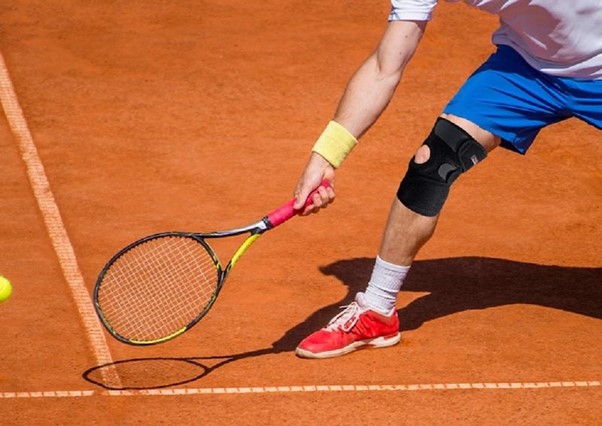
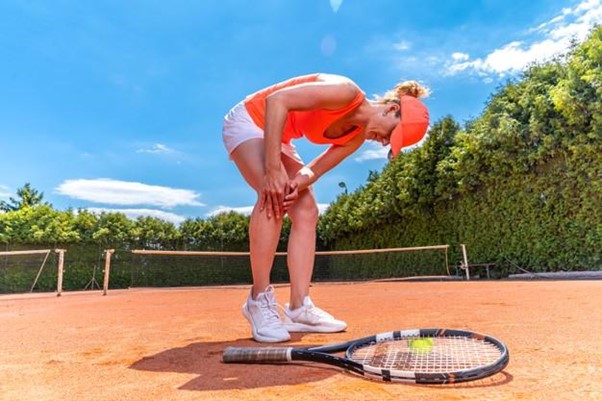
What to do now while waiting for diagnosis/treatment?
○ Self are with adequate rest, icing and anti-inflammatory medication are important measure to take while waiting for professional assessment for your knee pain.
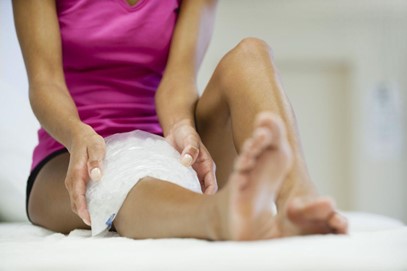
Cubital Tunnel Syndrome
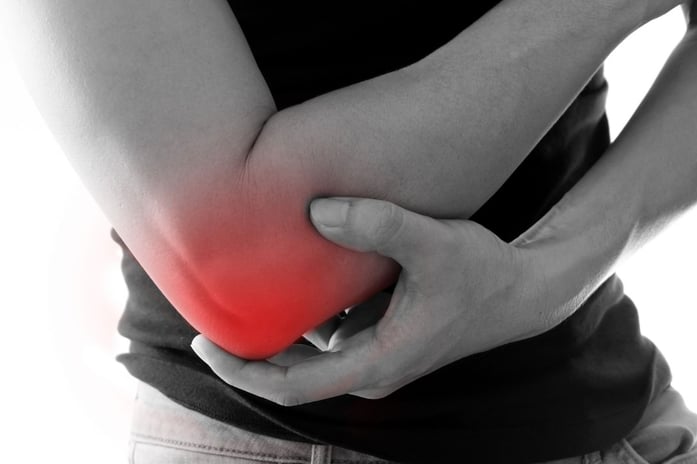
What is cubital tunnel syndrome?
○ This is a compressive neuropathy of the ulna nerve as it travels along the inner aspect of your elbow or humerus (“funny bone”). Irritation of this nerve is due to repetitive traction, compression and valgus stress associated with racket sports. The compression of the nerve is due to an overlying muscle (flexor carpi ulnaris). It is very rare to develop fractures around the elbow from tennis.
Symptoms
○ Tennis players with cubital tunnel syndrome may experience pain and numbness over the little finger and half of their ring finger. This unusual distribution of symptoms is due to the ulna nerve innervation of the fingers of your hand.
Causes
○ Your orthopaedic surgeon will assess your elbow and ensure your symptoms are due to cubital tunnel syndrome.
○ Symptoms such as a sudden onset of pain accompanied by popping may be due to ulna collateral ligament injuries and are managed differently.
Investigations
○ Your orthopaedic surgeon will investigate the cause of your elbow pain before prescribing the appropriate treatment for you.
■ Standard X-rays will give an idea of the bone structure of your elbow and exclude any arthritis of the elbow joint.
■ An ultrasound scan of the elbow will determine if the ulna nerve is stretched behind the medial epicondyle of the distal humerus as the elbow is extended and flexed. It can also look for compression of the nerve by the overlying Flexor Carpi Ulnaris (FCR) muscle.
What can happen if it’s left untreated?
○ Neglected cases may deteriorate into more serious injuries that require invasive and protracted treatment. It is best to seek professional help sooner and receive appropriate care for your injuries.
Treatment Options
○ Selfcare with adequate rest, icing and anti-inflammatory medication are important measure to take while waiting for professional assessment for your elbow pain
○ Splinting the elbow in an extended position at night helps to reduce the tension on the nerve and reduce symptoms.
○ If symptoms persist despite conservative treatment, surgery may be recommended by your orthopaedic surgeon.
■ A cubital tunnel decompression and ulna nerve transposition are procedures to reduce the compressive force on the nerve and to allow the nerve to take a shorter route towards the arm. In the transposition procedure, the nerve is taken from behind the elbow to a position that is anterior to the medial epicondyle. This reduces the distance the nerve is stretched as the elbow moves from an extended to flexed position. Less stretch on the ulnar nerves leads to less pain and numbness in the little and ring finger distribution.
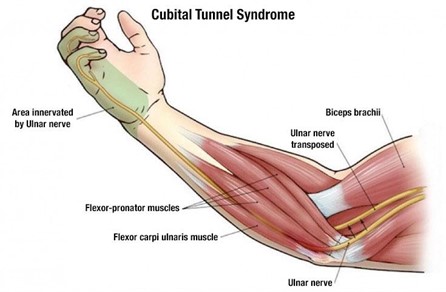
Recovery
○ It is important not to rush your recovery. Tendon healing takes time and rushing your return to sport may in fact delay your recovery.
○ It is important to allow time for the injured tendons and strained forearm muscle to rest and recovery. Physiotherapy is important to stretch out those tense muscles and help in its healing.
What to do now while waiting for diagnosis/treatment?
○ Take a break from racket sports and other aggravating physical activities. Make the necessary changes to your work and sports equipment to prevent further injuries.
○ Do indulge in selfcare such as rest, icing and anti-inflammatories to help your inflamed tendons and stress muscles recover.
Neck and Back Pain
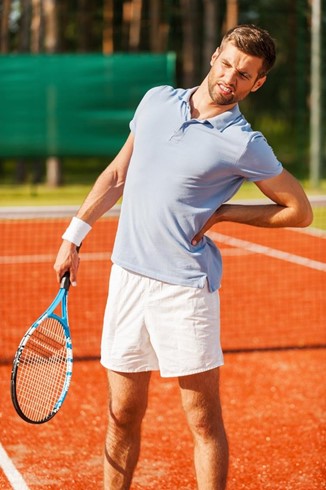
What?
Neck, upper and lower back pain are not uncommon in tennis. This may be due to several reasons such as intensity of games, poor playing technique, poor physical conditioning and falls. It is important to be able to identify regular muscle aches from strenuous tennis games versus actual injuries such as tendon inflammation or tears.
Symptoms
● General muscle aches tend to improve after a few days of rest with regular stretching. This is something all athletes experience regardless of the sport they enjoy. However if your pain is severe and limits your basic movement, is associated with muscle weakness or even numbness, it is best to get it assessed by a medical professional such as an orthopaedic surgeon or physiotherapist.
● As you move and twist your body on a forehand or backhand, lots of torque and power are applied to the muscles of your neck and back. Muscle spasms can occur as well as injuries to your intervertebral discs. Irritation of nerve roots may also lead to numbness and pain.
● Some signs that the pain you are experiencing is more serious than originally thought include the following:
● Constant pain at rest and at night despite adequate rest and care. Pain that wakes you up at night. Sharp shooting pain to your arms.
● Tingling, numbness and/or weakness in your arms and fingers
● Clumsiness in your hands eg difficulty holding a pen or chopsticks, unable to button your shirt
● Clumsiness or instability when walking
● Trouble going to the toilet
● Sharp shooting pain to your legs. This may or may not be associated with tingling and numbness in the calves or toes.
If you have these symptoms above, you are advised to seek medical help from a doctor or orthopaedic surgeon.
Assessment and Investigations
● If you continue to get debilitating pain in your neck or back after adequate rest, it is best for a medical professional to assess your symptoms and perform a thorough medical examination for you. This is to determine your basic movements, strengths and exclude any major or serious injuries.
● If there are worrying signs such as muscle weakness, numbness or abnormal gait, your orthopaedic surgeon may investigate your injuries further with x-rays and MRI scans of the injured area. This is to better assess the extent of injury and allow more targeting treatment for you. MRI scans are able to identify injuries such as bulging or torn intervertebral discs, nerve root impingement or degenerative conditions.
Treatment for Neck and Back Pain
● Prevention is always better than cure. A pre-game routine and stretch is crucial to prevent these injuries. A proper 5-to-10-minute stretch focusing on our necks, shoulders, upper and lower back is important both before and after your game. It’s always good to arrive about 30 to 45 minutes before a game. It calms us down and improves our tempo going into our game.
● Most muscle pain affecting the neck, upper and lower back improve with self care such as adequate rest from tennis, stretching, simple anti-inflammatory medication and management of swelling. Ice packs help to reduce joint swelling and allow a faster return to sport.
● If there are no major injuries detected on the MRI scans, a course of physiotherapy will help identify tight and injured muscles or tendons and allow effective rehabilitation.
● If there are injuries to the intervertebral disc or nerve impingement, an initial course of medication will help relieve your symptoms.
What to do?
● Do seek professional medical help if you are experiencing severe and debilitating pain that affects your daily activities and quality of life. An accurate diagnosis goes a long way in reassuring you and allowing you to receive treatment sooner rather than later.
Here are several tips you may adopt to protect your shoulder from injury.
● Stop playing if your shoulder is hurting while playing tennis. You can always return to the game another day once your shoulder is better.
● Ensure you have adequate rest after each strenuous tennis session. You may use ice and anti-inflammatory medicine to reduce the pain and swelling in your shoulder if present.
● Be sure of your tennis swing and biomechanics with your tennis pro.
● Strengthen the muscles around your shoulder and back at the gym. There are many muscles in our body which have to work together and harmoniously. Strong muscles help prevent injuries and compensate for injuries around your joints.
● It is important to do your regular stretching before and after any tennis game or practice. Tightness in one muscle may lead to pain in another. The trapezius and latissimus dorsi muscles are major muscles in your back and may cause significant pain if they are injured.
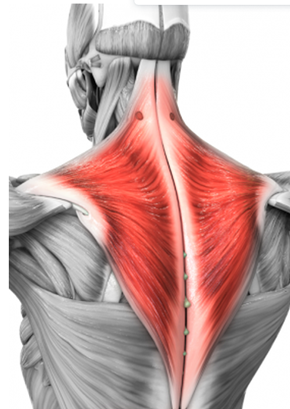
Trapezius muscles in your upper back and neck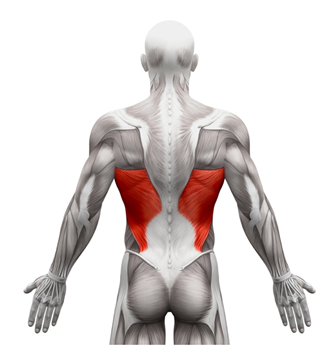
Latissimus Dorsi muscles in your lower back
Statistics
Factual sentences referenced across top search results:
● About 2% of people are affected. (en.wikipedia.org)
● Patients that received corticosteroid injection also had a higher recurrence rate at 1 year versus placebo (54% versus 12%, relative risk 0.23). (en.wikipedia.org)
● Response to initial therapy is common, but so is relapse (25% to 50%) (en.wikipedia.org)
● In tennis players, about 39.7% have reported current or previous problems with their elbow. (en.wikipedia.org)
● Less than one quarter (24%) of these athletes under the age of 50 reported that the tennis elbow symptoms were "severe" and "disabling," while 42% over the age of 50 did. (en.wikipedia.org)
● More women (36%) than men (24%) considered their symptoms severe and disabling. (en.wikipedia.org)
● Tennis elbow is a common condition that affects about 1-3% of the population (about 4 to 7 cases per 1000) every year. (nhs.uk)
● Tennis elbow usually lasts between 6 months and 2 years, with most people (90%) making a full recovery within a year. (nhs.uk)
● 50 percent of tennis players will experience tennis elbow. (medicalnewstoday.com)
● Tennis elbow affects 50 percent of tennis players. (medicalnewstoday.com)
● Only 21% (7 of 33) of the patients' surgeons approved of their patients undertaking tennis activity, with 45% (15 of 33) recommending only doubles tennis. (pubmed.ncbi.nlm.nih.gov)
● Osteoarthritis is the most common form of arthritis and affects more than 32 million U.S. people Trusted Source 80 percent Trusted Source of osteoarthritis cases are in the knee. (healthline.com)
● At least 19 percent of adults in the United States ages 45 or older are affected by knee osteoarthritis. (healthline.com)
● All fans would like a repeat of 2017, but it doesn't take a world-renowned fitness trainer to realise that will be unlikely given the seriousness of the two surgeries and the length of time away from even basic fitness training. (perfect-tennis.com)
● From 1998 to 2008, the number of knee replacements among Americans aged 45 to 64 more than tripled to about 253,000 from about 70,000, according to the American Academy of Orthopaedic Surgeons. (everydayhealth.com)
● “Now, much like I did leading up to the 2017 season, I plan to take the necessary time to be 100 per cent ready to play at my highest level,” he said. (straitstimes.com)
● This is a progressive condition that slowly wears away at the joint cartilage and affects over 12% Americans. (ustahawaii.com)